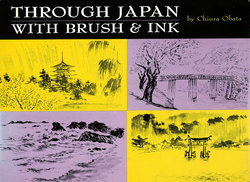Читать книгу Through Japan with Brush & Ink - Chiura Obata - Страница 8
На сайте Литреса книга снята с продажи.
Оглавление§ 1. The Human Wave of Tokyo
Imagine this city of over ten million people, this capital city whose population accounts for more than a tenth of the Japanese nation. Everywhere one looks there is bustle and stir; every place a person walks he feels himself colliding with a tidal wave of humanity, whether in the Ginza, Asakusa, Ueno, Tokyo Station, Hibiya, or any other district of this megapolis. Then, too, one is aware of endless buildings rising toward the heavens. At such moments one feels as though he were hopelessly trapped by these waves of humanity between the endless man-made canyon walls; so much so that once he finds himself again in the open countryside where the old eternal modes of farming persist, it is as though he had been suddenly transported to another world remote from modern man.
§ 2. Visitors at the Imperial Palace Plaza
On longer acquaintance, however, after the visitor has became more used to the throngs of people everywhere on the streets of Tokyo, he becomes aware of individuals and types. For example, here at the Imperial Palace Plaza, he sees many groups of tourists, young and old, men and women, from all provinces and nations, arriving and departing every hour of the day. Then, too, there are those platoons of school children—boys and girls in their navy blue uniforms—parading around the plaza continuously. The tiniest of them have quaint yet practical tags sewed on their uniforms identifying them, in the event of a mishap, by name and school. Each flock seems shepherded by a teacher carrying a small pennant, apparently designed to keep his little troop in line and to avoid losing any of his wards.
§ 3. Asakusa Kannon Temple
Though all of Tokyo's ten million live in crowded quarters, the most teeming quarter of all is that surrounding the Asakusa Kannon Temple. In all the streets radiating from the temple's main entrance, one finds people closely packed together like sardines. In front of the temple there is a large wooden offering box into which the pilgrims drop their coins. Above this box a huge lantern hangs. A strange custom dating back to the Edo period still persists here, for on this lantern one sees inscribed the names of the leading geisha girls and geisha house owners.
§ 4. Kabuki Theater
Kabuki has come to epitomize the artistry as well as the magnificence of Japanese culture. It is no wonder then that the Kabuki Theater has been accepted as a rendezvous in the capital city for cultured people from all over Japan, as well as for distinguished visitors from abroad. During the performances given in this palatial theater, the audience senses all those spiritual qualities, those noble feelings that characterize the Japanese people at their best—a subtle blending of taste, tradition, and technique that enables this nation to give vent to its feelings without losing dignity and without sacrificing beauty.
§ 5. The Tokyo International House of Japan
A very important gathering place for foreign scholars and students, the Tokyo International House of Japan is located at Toriizaka, Azabu in Tokyo. In addition to housing lecture halls and halls for social affairs, it has facilities for boarding and lodging numbers of visitors from distant lands. Formerly the private estate of Baron Iwasaki, the grounds surrounding International House offer its visitors the comfort and delight of a beautifully laid out and carefully maintained Japanese garden in the great tradition.
§ 6. Night Scene on Ginza
All hues of neon lights flash in the night sky. Like dancers in the street, Ginza's endless streams of human souls move on and on. The walk is called gimbura, meaning without any set purpose or destination.
§ 7. Kamakura Beach
Along the undulating shoreline's length all the way from Odawara to Chigasaki, Oiso, and Enoshima, the traveler is charmed by the sight of small boats wavering like sea birds along the sand dunes.
